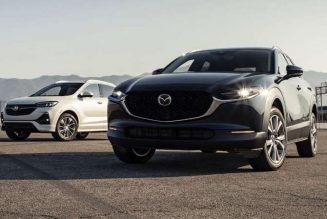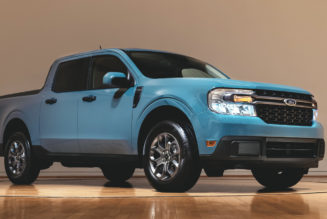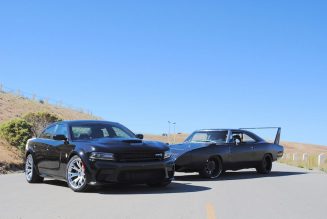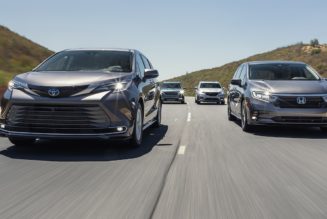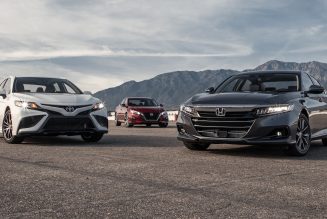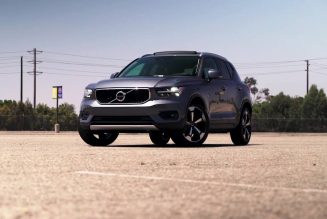They used to rule the road, these nimble, compact rear-drive sedans, ready to shred Angeles Crest upon request and zip across states with swift composure. But with SUVs now the first choice of the majority of Americans, a shrinking number of these performance-minded sedans reside in showrooms in hopes that someone might be smitten with a design that is more sleek than chunky.
Comparing similar mainstream and luxury cars can’t get much closer than this. Kia and Genesis are both part of the Hyundai Motor Group. The two cars are built on the same platform. They share the same engines and transmissions and countless other bits and bobbles.
In the industry’s distant past, lazy, cynical product planning would mean they’d be literally the same car with different badges. Today, they demonstrate just how different the same hardware can be tuned and tweaked to accomplish different missions.
“They’re very different cars,” road test editor and co-judge Chris Walton said. “It is remarkable that they can start from the same template and come out the other side so different.”
What It’s Like to Drive the G70 and the Stinger
The Stinger GT’s mission is right there in its name. Kia boldly launched its sport sedan at the Nürburgring, we then invited it to our annual Best Driver’s Car competition, and it has proven itself to be a worthy, sporty, powerful grand touring car.
This particular as-tested car has all the performance parts—but although stiff springs improve handling numbers, the Stinger still has plenty of suspension travel and somewhat soft anti-roll bars. This gives the car a more relaxed demeanor, a cruiser with a distinct sporty edge rather than a full-time sport sedan.
The Kia is never going to feel as light and lithe as the G70, though. With its shorter wheelbase, the Genesis wears its sportiness on its sleeve, ready to attack a corner at any moment. It’s laser-focused on beating the best luxury sport sedans in the world at their own game—as it showed when it won our 2019 Car of the Year nod. There’s significantly less body roll in corners and vertical motion over bumps. It’s buttoned-down and buttoned-up.
Still, a luxury sport sedan isn’t a race car, so the G70 has a generous amount of compliance in the suspension to keep bad roads from rattling your brain around inside your skull. Because it doesn’t have to amp up the sport factor—even in Sport mode—the G70 rides more sweetly, absorbing bumps and broken pavement more gently than the Stinger. It’s a delicate balance some luxury sport sedans don’t quite get right, but the Genesis does.
“I wasn’t expecting the G70’s ride to be this plush,” Walton said. “What a truly well-rounded and fun car. I could live with the Stinger’s ride, but given the choice, I prefer the Genesis.”
Now would be a good time to stop and recognize the elephant in the room. Although these two have the same chassis, 3.3-liter twin-turbo V-6 engine, and eight-speed automatic transmission, they are not at all identical. The Stinger Kia was able to provide us is the limited edition GTS model, which means it’s all-wheel drive. Our G70 is rear drive. The GTS is a one-year deal, a sport package for all-wheel-drive, six-cylinder Stingers designed to address criticism of the base all-wheel-drive system’s effect on steering.
Thankfully, this isn’t a track test. If it were, we might take note of the difference in steering feel, but that’s hardly critical to a decision between a mainstream car and a luxury car. We cannot avoid, however, taking note of the difference in curb weight. There’s no getting past that the Kia is a significantly heavier car, but we can couch it. Based on our past testing data, the all-wheel-drive system adds about 140 pounds, so we can forget that. Even after that, however, it leaves us with a car 170 pounds heavier than the G70. Most of that you can attribute to the Kia’s big rear hatch, which is not only heavier than a traditional trunk but also requires a bigger, heavier roof frame to hold it up. It’s not an enormous amount of weight, but the extra range of motion in the suspension amplifies the weightiness every time you turn.
Is the G70 Faster Than the Stinger?
It’s also evident in the Kia’s acceleration, just noticeable when hitting the highway but more so under instrumented testing. Although both sedans have the same engine, transmission, gear ratios, and final drive ratio, Stingers consistently run a bit slower than G70s in our testing. Most folks won’t notice the Stinger’s half-second lag on the way to 60 mph, but in practice it means the G70 feels a bit more urgent and unrelenting when you get on the gas. The 314-pound weight difference doesn’t affect braking, however. Likewise, lean them into a corner, and the two produce nearly identical results in our figure-eight test.
More critical for this comparison, the Stinger’s need to provide sporty handling when asked has necessitated stiffer dampers, which hurt ride quality. The G70, riding on the same size wheels and identical tires, handles small and large impacts more gently, transmitting less shock to the cabin and occupants. What’s more, the G70 allows noticeably less tire noise into the cabin. Which raises the question: What sort of magical, weightless, noise-reducing sheeting does Genesis use?
Stinger Interior vs. G70 Interior
The cabin experience is a defining trait of a luxury car, and this is where the Genesis really shows its value. The G70’s interior is quieter, partially because it doesn’t have the squeaks and creaks of the Stinger (which had many fewer miles on it). The Stinger also suffered a bit of wind noise on the freeway; the G70 didn’t. Getting on the freeway, the G70’s engine note is also sweeter than the Stinger’s, which is dull and tends to drone. To repeat, it’s the same engine in both cars. Luxury means paying attention to details like this.
Beyond the aural realm, the G70 impresses throughout the rest of the interior. The leather in the seats and padding feels a grade richer and softer. The switchgear feels heftier and has more expensive-looking finishes—including knurled knobs on the steering wheel, where the Kia runs with plain toggle switches. Genesis even puts extra passenger-seat controls where the driver can reach them when acting as a chauffeur (on the side of the front passenger seat, above the center armrest). Both cars have metal speaker covers, but again, the Kia’s look somewhat industrial next to the G70’s high-end audio appearance. The G70 also comes out of the gate with a large, full-color screen embedded in the instrument gauges, which you can get on the Kia for an extra charge. The Kia’s standard black and white affair looks out of place in 2020.
Still, the Stinger remains competitive. This GTS model gets a suede leather steering wheel we hope becomes available on other models. Its seats aren’t exclusive to the GTS, and their bottom cushions are more comfortable than the G70’s on a long drive. Both cars have similar rear seat space, though the Stinger offers both 12-volt and USB power ports in back while the Genesis only provides a single USB. Subjectively, the Kia’s dashboard and center stack design carries more personality, while the G70 is full of subtle Audi cues, no doubt intentional to establish its credentials as a luxury car.
“It does what the benchmarks do but does so in a more subtle way and with a style all its own,” Walton said.
Stealing from the best or not, the G70 uses larger buttons and dials for many of its controls, particularly the HVAC, making them easier to find at a glance or without looking. It also has controls the Stinger doesn’t to operate features our Stinger lacks, such as adaptive cruise control and lane keeping (available on the similarly priced Stinger GT1 trim). The G70’s wireless phone charging pad also works better; the Kia’s got so hot the phone couldn’t charge. Likewise, our drinks were getting warm in the Kia’s cupholders from all the heat coming up through the transmission tunnel.
“There’s still a cheapness to the Stinger’s interior,” Walton said, “which wouldn’t be hard to upgrade with better textures and less obvious plastics.”
There’s little need to compare the Kia and Genesis infotainment systems because they’re identical, down to the housing. Some may count this as either a demerit to the Genesis or a bonus to the Kia, depending on perspective. Regardless, the Hyundai/Kia/Genesis user interface is one of the best on the market in terms of usability, so it’s hard to fault regardless of application.
The Stinger’s hatchback, with a large space to stack bags and a huge opening to lift them through, is a boon to travelers who don’t pack light. It comes at the price of rear visibility, however. The rear window is small and mounted high in the hatch, so you can’t see anything below the height of the rear headrests. The G70, by contrast, has excellent outward visibility to the rear and corners. There’s no interior hatch release button on the Kia, and getting a powered rear hatch requires upgrading to the top trim level.
“I prefer the Stinger’s stealthy hatchback for luggage,” Walton said, “yet looking through the rearview mirror, it is a much smaller slit of a window, with a bit of a fun-house-mirror effect.”
Is The G70 Worth It?
With the two so evenly matched, the “worth it” question comes down to value. Typically, you’d expect to pay a premium for the “luxury” brand. This whole series of comparison tests is predicated on it. Control for variables like the all-wheel drive vs. rear drive mismatch, though, and the Stinger and G70 are priced nearly identically as tested. Even if you swap the sold-out Stinger GTS for a similarly priced and equipped Stinger GT1, it lands right on top of the G70 with its one Elite options package, which adds rain-sensing wipers, parking sensors, wireless charging, a sunroof, and adaptive headlights. What’s more, the GT1 isn’t the most expensive Stinger. The GT2 model adds more features, and there are plenty more features you can add to a G70.
“In my head, this choice really boils down to luxury versus sport, instead of whether luxury is worth it,” Walton said. “In this case, I prefer luxury, especially since it’s less expensive than Kia’s definition of sport. The G70 was a game changer, and it’s still holding up quite well.”
Were the G70 a little more expensive, it still would be fairly easy to justify the stretch. The Stinger is everything you want and need, but the Genesis is just a bit nicer to live with, so why not spend a (very) few more bucks? If you can afford the Stinger, you can afford an even nicer G70.
| 2019 Genesis G70 3.3T (RWD) | 2019 Kia Stinger GTS AWD* | |
| BASE/AS-TESTED PRICE | $44,745/$46,495 | $47,395/$47,670 |
| LAYOUT | Front engine, RWD, 5-pass, 4-door sedan | Front-engine, AWD, 5-pass, 4-door hatchback |
| ENGINE | 3.3L/365-hp/376-lb-ft twin-turbo DOHC 24-valve V-6 | 3.3L/365-hp/376-lb-ft twin-turbo DOHC 24-valve V-6 |
| TRANSMISSION | 8-speed automatic | 8-speed automatic |
| CURB WEIGHT (F/R DIST%) | 3,833 lb (53/47%) | 4,147 lb (53/47%) |
| WHEELBASE | 111.6 in | 114.4 in |
| L x W x H | 184.5 x 72.8 x 55.1 in | 190.2 x 73.6 x 55.1 in |
| 0-60 MPH | 4.5 sec | 5.1 sec |
| QUARTER MILE | 13.0 sec @ 108.5 mph | 13.6 sec @ 104.8 mph |
| BRAKING, 60-0 MPH | 109 ft | 104 ft |
| LATERAL ACCELERATION | 0.92 g (avg) | 0.90 g (avg) |
| MT FIGURE EIGHT | 24.9 sec @ 0.77 g (avg) | 25.2 sec @ 0.77 g (avg) |
| EPA FUEL ECON | 17/26/20 mpg | 17/25/20 mpg |
| ENERGY CONSUMPTION, CITY/HWY | 198/130 kW-hrs/100 miles | 198/135 kW-hrs/100 miles |
| CO2 EMISSIONS, COMB | 0.96 lb/mile | 0.98 lb/mile |
| ON SALE | Currently | Currently |
| *Kia curb weight and test figures measured on a 2018 Stinger GT1 AWD model. | ||
More Videos


